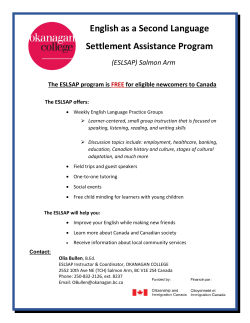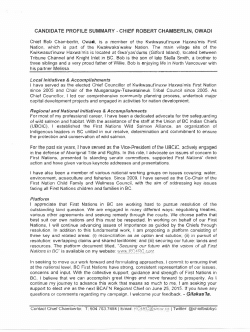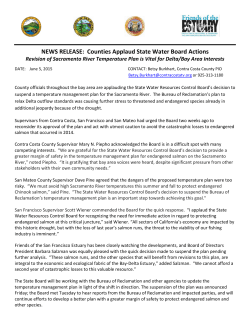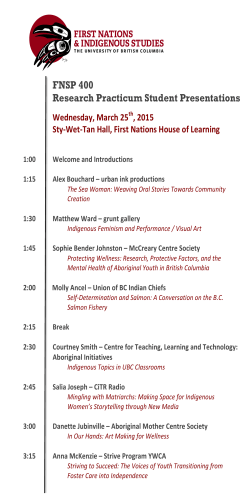
Heading 1 - Natural Resources Wales
Board Paper 7th May 2015 Paper Title Evidence Paper: The Current Status of Salmon and Sea Trout in Wales Paper Reference: NRW B B 28.15 Paper Prepared By: Peter Gough Purpose of Paper: To provide the evidence on the status of our salmon and sea trout stocks and the implications for future stock management. Recommendations: The Board is requested to:1. Note the current status of our salmon and sea trout stocks. 2. Recognise the declining trend and consider implications for future stock management. 3. Provide advice for the next phase of work in which we will identify options to restore stocks taking a natural resource management approach. Decision Required: Impact: To note – all headings might not be applicable to the topic To note the new stock assessment results. Impact on the Environment: Fish require good water quality and availability and access to good quality habitat. They are a key indicator of ecological performance and environmental quality. Impact on the Economy: Wales’ fisheries have an important role in providing jobs and income in commercial and recreational fishing, fisheries management and tourism. Impact on Community: Fish can play an important role in engaging people in their environment and providing opportunities for education, recreation and health benefits associated with encouraging people to get out into the natural environment. Page 1 of 6 www.naturalresourceswales.gov.uk Impact on Knowledge: We need a strong evidence base to inform our advice to Welsh Government on natural resource management and the policies needed to deliver the ecosystem approach. We need evidence to inform Natural Resources Wales’ decision making and to inform discussions with partners and co-deliverers. Page 2 of 6 www.naturalresourceswales.gov.uk Issue 1. This paper presents the outcome of salmon and sea trout stock assessments for Wales. 2. Salmon stocks in all principal salmon rivers in Wales, including those in the seven Natura 2000 sites where the species is a feature and in the three cross-border rivers, are now classified as either ‘At Risk’ or ‘Probably at Risk’ of failing to achieve stock targets in 2014. All but one are forecast to remain in these classes until at least 2019. 3. Nearly half of the sea trout stocks in our 33 main sea trout rivers are assessed as either ‘Not at Risk’ or ‘Probably Not at Risk’. 4. The poor status of many populations requires us to identify measures to restore stock status. This includes the actions that need to be taken over the full life cycle of salmon and sea trout, the potential introduction of new restraint on the number of fish being killed by anglers and netsmen and investment in habitat restoration and protection. 5. Proposals for stock restoration will be developed for a future Board paper. We will work with partners on the development of the actions needed. Background Salmon 6. Each year we assess the status of our salmon stocks in the 23 principal salmon rivers in Wales by comparing spawning escapement estimates in each river to the respective stock targets. 7. Salmon socks in all of our rivers are now assessed as either ‘At Risk’ or ‘Probably at Risk’ of failing to achieve stock targets in 2014 and all but one are forecast to remain in this condition in 2019, which is as far ahead as our procedures can predict. Only 2 of the rivers show a positive trend in egg deposition estimates over the last decade. Page 3 of 6 www.naturalresourceswales.gov.uk 8. These measures are also used in part to determine the condition of salmon as a feature of the N2K sites, and consequently these sites are not achieving their conservation objectives. 9. Over the past few decades there has been a general pattern of stock decline that is reflected in the performance of salmon rivers on a wide geographic scale. This is recognised by all agencies involved with international salmon stock management. It is recognised that the major factor causing this is the decline in marine survival of fish, which is probably related to environmental change in the north Atlantic. 10. We need to work with Welsh Government to determine what can be done to reduce the mortality of salmon at sea. However, there remains work to be done to restore and improve freshwater habitats to maximise smolt production and output. 11. Whilst this is underway it is now more important than ever that the number of salmon surviving to spawn each year is maximised by reducing the number of fish killed in rod and net fisheries. Sea Trout 12. We also assess sea trout stocks in 33 rivers, using temporal trends in catches. This is a less sophisticated method than that used for salmon, because of the relative complexity of the sea trout / brown trout complex and consequently the lack of biological reference points which would be comparable to the salmon conservation limit. 13. Assessments for 2014 are yet to be finally checked, however they are likely to indicate that about 50% of stocks are either ‘Not at Risk’ or ‘Probably Not at Risk’. We are currently unable to forecast future performance of stocks. 14. Although these stock assessments give rise to fewer concerns, we will not be complacent with this important resource. We are aware of local issues affecting sea trout stocks and fishing, and that some stocks are currently at low levels. We will take full account of these in our forthcoming options paper. Review of Net Limitation orders 15. Fishing for salmon and sea trout in coastal and estuarine public fisheries in Wales is regulated by a system of licences and byelaws. Using powers under SAFFA 1975 (as amended) we regulate fishing pressure by limiting the number of licences issued. These Net Limitation Orders (NLOs) last for periods of up to 10 years and, prior to expiry, we must review these to ensure that regulation matches fishing pressure to exploitable stocks. Page 4 of 6 www.naturalresourceswales.gov.uk 16. There are currently two NLOs in Wales, one in the Dee Estuary where a NLO review is at an advanced stage with a submission for approval of the order ready to go to ministers in Welsh Government and DEFRA. The remaining public fisheries in south-west and north Wales are currently aggregated within a single NLO and work must commence later this year to build the technical case prior to public consultation on proposed controls. 17. The status of our migratory salmonid stocks will inform the technical assessment. Other Matters 18. We note that Wales is not alone in suffering declines in salmon stock status. Radical salmon catch control measures are currently being implemented in Scotland, Ireland and Canada and are now being considered in England. 19. In considering options for the future we will consider that: We do not believe that angling or net fishing are the reasons for the poor status of fish stocks. However maximising the numbers of fish that survive to spawn, whilst habitat repair and improvements works following the principle of natural resource management proceed, is very important Marine survival of salmon is at a historically low level It is vital that we continue to invest in freshwater habitat restoration in order to raise to optimum levels the production of salmonids in our rivers. Recommendations 20. The Board is requested to: Note the current status of our salmon and sea trout stocks. Recognise the declining trend and consider implications for future stock management. Provide advice for the next phase of work in which we will identify options to restore stocks. Next Steps 21. We will now commence preparation of options for measures to restore and protect the migratory salmonid resource in Wales, recognising the important role they play in maintaining socio-economic benefits, often in rural Wales. 22. We will initiate and maintain a communication and engagement plan under which we will seek to work with others to identify issues and implement solutions. Page 5 of 6 www.naturalresourceswales.gov.uk 23. We will debate options with partners and stakeholders to achieve shared recognition of the issues and the best means to deliver action to improve our fisheries resource. Risks Legal Challenge 24. None currently, however some of the options that we identify might prove to be unpalatable, triggering challenge. Communications 25. We hope that stakeholders will fully engage with the issues and process we will set out, however we are aware that some may choose not to. Resources 26. Some of the options will require substantial staff resource that the business may struggle to commit. Financial Implications 27. These will need to be assessed for the range of options we identify. There is a need to identify new funding sources for sustained habitat restoration. Equality Impact Assessment N/A. Page 6 of 6 www.naturalresourceswales.gov.uk
© Copyright 2026









